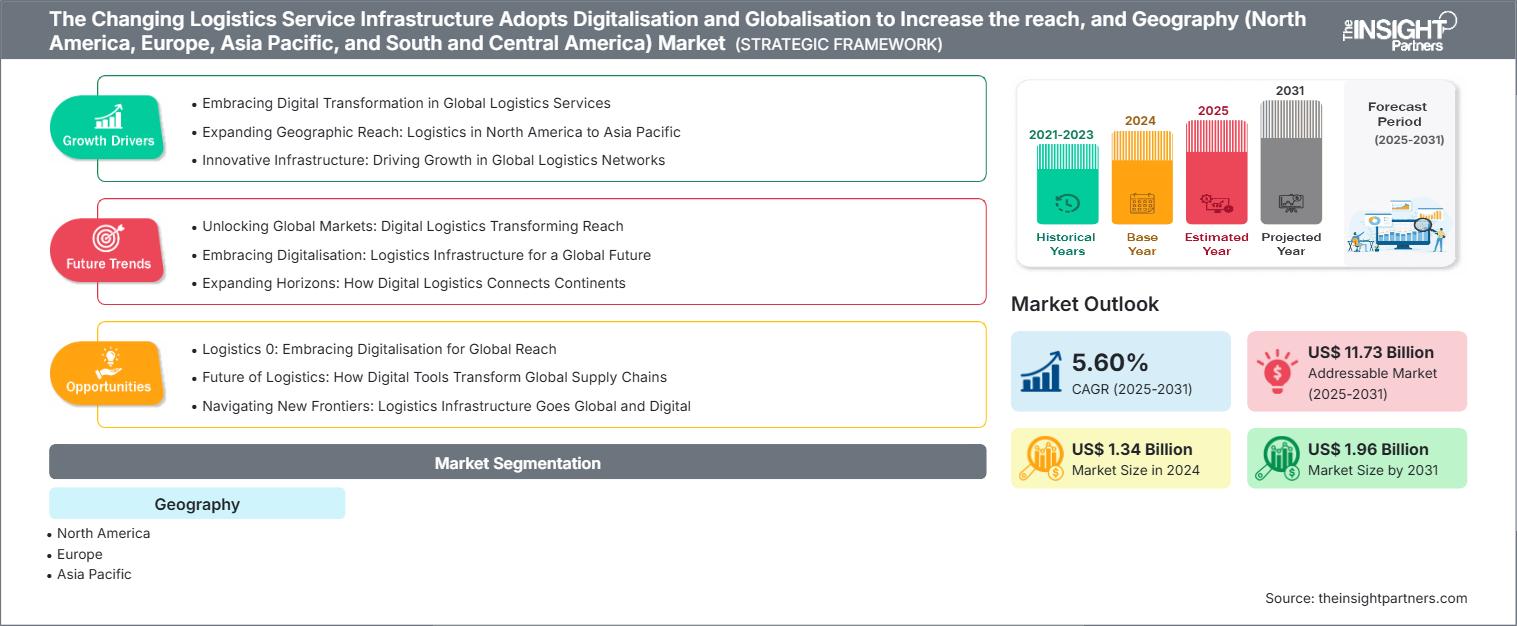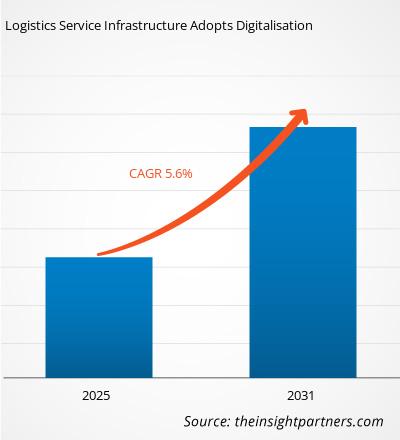预计物流服务市场规模将从 2021 年的 10.7747 亿美元增至 2031 年的 17,582.2 亿美元,预计 2021 年至 2031 年的复合年增长率为 5.6%。
各行各业都越来越依赖提高运营效率,同时通过外包物流业务和特定供应链流程来降低运营成本的做法也日益盛行。此外,第三方物流和第四方物流公司的出现也增加了全球对物流服务提供商的需求。货运代理、货运管理、咨询、路线优化、网络分析、项目管理、库存和仓储管理以及供应链咨询是领先物流公司提供的主要服务。此外,使用技术驱动的物流服务所带来的各种好处,例如实时跟踪和监控、分析、预测和规划,进一步增加了市场参与者的盈利能力。由于存在多家专门提供各种物流服务的企业以及庞大的客户群,物流服务行业极其分散。
来自亚洲和非洲等新兴经济体的国内企业正以稳定且具有竞争力的物流服务价格进一步加剧市场竞争。供应链网络不断变化,从而开辟了新的贸易走廊。能够利用这些新贸易走廊的组织和经济体有望从全球贸易发展中获得最大收益。预计这些机遇的一部分将来自于分享一套在发达市场广泛应用但在许多发展中国家应用有限或尚未实施的全面最佳实践。人力资源管理战略和咨询服务,例如管理会计系统、多元化管理、知识共享、先前自由化进程中的关键绩效指标 (KPI),以及制定强有力的企业社会责任 (CSR) 实践。由于持续的投资、新产品的开发和现代技术的整合,全球物流服务行业预计将在未来几年快速扩张。物流服务市场由少数知名的全球企业主导,这些企业不断投资研发,以为客户提供最佳服务。在地域发展和技术改进方面,物流服务提供商,尤其是第三方服务提供商,正在经历巨大的增长。例如,第三方物流 (3PL) 机构目前正在其运营中采用各种基于软件的解决方案,以降低效率和成本。此外,在仓库管理系统的通信中实施语音识别软件可以支持订单处理和库存记录,从而减少对员工及其培训的需求。亚太地区占据物流服务市场的大多数份额,预计在预测期内将实现最高的复合年增长率。
您将获得任何报告的免费定制,包括本报告的部分内容、国家级分析、Excel 数据包,以及为初创企业和大学提供优惠和折扣
不断变化的物流服务基础设施采用数字化和全球化来扩大覆盖范围和地域(北美、欧洲、亚太地区以及南美和中美)市场:战略洞察

-
获取此报告的顶级关键市场趋势。此免费样品将包括数据分析,从市场趋势到估计和预测。
COVID-19疫情对物流服务市场的影响
新冠疫情的爆发在2021年末和2021年影响了世界经济,包括:航班取消、旅行禁令和隔离,导致全球整体供应链和物流活动大幅放缓。参与货物运输、仓储和流通的物流公司直接受到新冠疫情的影响。然而,一些行业在与疫情作斗争,而另一些行业则蓬勃发展,例如医疗保健和制药行业。在新冠疫情期间,电子商务和日用品也将对全球物流行业产生积极影响。此外,对医院用品、手套、消毒剂、疫苗和新鲜食品等医疗和快速消费品的需求不断增长,正在推动新冠疫情期间物流市场的增长。
物流服务市场:市场洞察
电子商务行业的增长与逆向物流业务的兴起
电子商务是指通过互联网进行商品买卖。除了将产品交付给消费者的常规功能外,物流服务提供商还通过管理和监控电子商务业务的供应链来满足电子商务行业的需求。这使得这些企业能够专注于市场营销和其他业务运营。物流对电子商务行业的益处显著提高了全球对物流服务的接受度。根据联合国贸易和发展会议(UNCTAD)2021年4月发布的最新报告,2021年全球电子商务销售额达到25.6万亿美元,约占全球国内生产总值(GDP)的30%。2021年,全球B2B电子商务业务价值为21万亿美元,约占全球电子商务总额的83%;此外,B2C电子商务价值为4.4万亿美元。这一增长归因于跨境购物的快速增长。 2021年全球网购人数超过14亿,美国、中国、日本企业占据全球电商销售主导地位。
不断变化的物流服务基础设施采用数字化和全球化来扩大覆盖范围和地域范围(北美、欧洲、亚太地区以及南美和中美)市场区域洞察
Insight Partners 的分析师已详尽阐述了预测期内影响“不断变化的物流服务基础设施采用数字化和全球化来扩大覆盖范围”以及“地域分布(北美、欧洲、亚太地区、南美洲和中美洲)”市场的区域趋势和因素。本节还讨论了“不断变化的物流服务基础设施采用数字化和全球化来扩大覆盖范围”以及“地域分布(北美、欧洲、亚太地区、南美洲和中美洲)”的细分市场以及北美、欧洲、亚太地区、中东和非洲以及南美洲和中美洲的地域分布。
不断变化的物流服务基础设施采用数字化和全球化来扩大覆盖范围和地域范围(北美、欧洲、亚太地区以及南美和中美)市场报告范围
| 报告属性 | 细节 |
|---|---|
| 2024年的市场规模 | 13.4亿美元 |
| 2031年的市场规模 | 19.6亿美元 |
| 全球复合年增长率(2025-2031) | 5.60% |
| 史料 | 2021-2023 |
| 预测期 | 2025-2031 |
| 覆盖地区和国家 |
北美
|
| 市场领导者和主要公司简介 |
|
不断变化的物流服务基础设施采用数字化和全球化来扩大覆盖范围和地域(北美、欧洲、亚太地区、南美和中美)市场参与者密度:了解其对商业动态的影响
不断变化的物流服务基础设施采用数字化和全球化技术,以扩大覆盖范围,并拓展地域范围(北美、欧洲、亚太地区以及南美和中美)。市场正在快速增长,这得益于终端用户需求的不断增长,而这些需求的驱动因素包括消费者偏好的演变、技术进步以及对产品优势的认知度的提高。随着需求的增长,企业正在扩展其产品线,不断创新以满足消费者需求,并利用新兴趋势,从而进一步推动市场增长。

- 获取不断变化的物流服务基础设施采用数字化和全球化来扩大覆盖范围和地理区域(北美、欧洲、亚太地区、南美和中美)市场顶级关键参与者概览
基于交通方式的市场洞察
高效运输是指以相对安全的方式、在正确的时间、在正确的条件下、以经济高效的方式进行货物的物理运输。运输在将货物从制造地或仓储地运送到使用地或配送地以及最终消费地的过程中发挥着重要作用。根据运输方式,物流服务市场可细分为公路、铁路、水路和航空。选择运输方式的标准取决于货物和运输途中的货物的物理特性。在某些情况下,公路和铁路的破坏等环境因素会对运输方式的选择产生重大影响。
基于物流供应商的市场洞察
全球物流服务市场按组成部分类型细分为第一方和第二方物流、第三方物流、第四方物流和第五方物流。第三方物流供应商 (3PL) 为企业提供部分(有时是全部)供应链管理功能的物流服务。将物流外包给第三方供应链管理公司是一个持续的趋势。目前,物流服务市场规模估计为 10774.6 亿美元,其中很大一部分物流服务外包给第三方。然而,各国外包程度差异很大。一般而言,外包是英国和美国的首选物流活动,而中国和印度的第三方物流业务未来增长潜力巨大。
基于组织规模的市场洞察
对于涉及货物运输的企业来说,物流服务至关重要。为了避免流程中的复杂化,各种中小企业和大型企业都在采用物流服务。随着技术的快速发展,许多中小型企业和大型企业都选择物流服务,这使得它们能够将精力集中在核心竞争力、公司重组和成本削减上。根据企业规模,全球物流服务市场细分为中小型企业和大型企业。
产品开发是企业扩展产品组合的常用策略。联邦快递、马士基、DHL、UPS、Expeditors 等公司是实施此类策略的主要参与者,旨在扩大其在物流服务市场的客户群和收入份额,从而维护其品牌声誉。以下列举了近期的一些关键发展:
- 2021年11月,全球集装箱物流整合商AP穆勒-马士基与沙特港务局签署了一项最终协议,将建设一个占地20.5万平方米的综合物流园区,该园区将为客户提供广泛的仓储配送、冷藏和电子商务基础设施。该设施还将作为转运、石化产品整合、空运和集装箱货运的枢纽。
- 2021年1月,联邦快递和微软宣布推出面向电商行业的全新跨平台物流解决方案。该解决方案旨在通过提升客户参与度和提供更丰富的运输选项,提升商家在电商领域的竞争力。
物流服务市场根据运输方式、物流供应商、组织规模和最终用户进行细分。根据运输方式,市场细分为公路、水路、铁路和航空;根据物流供应商,市场分为第一方和第二方物流、第三方物流、第四方物流和第五方物流;根据组织规模,市场细分为中小型企业和大型企业;根据最终用户,市场进一步细分为政府和公共事业、医疗保健、工业制造、零售和消费品、航空航天和国防等。
CEVA Logistics;Panalpina World Transport (Holding) Ltd.;联合包裹服务公司 (UPS);CH Robinson Worldwide, Inc.;AP MOLLER – MAERSK;日本通运;联邦快递;DB Schenker;DHL International GmbH;以及 KUEHNE + NAGEL 是全球物流服务市场上的几家主要参与者。
- 历史分析(2 年)、基准年、预测(7 年)及复合年增长率
- PEST和SWOT分析
- 市场规模、价值/数量 - 全球、区域、国家
- 行业和竞争格局
- Excel 数据集
近期报告
客户评价
购买理由
- 明智的决策
- 了解市场动态
- 竞争分析
- 客户洞察
- 市场预测
- 风险规避
- 战略规划
- 投资论证
- 识别新兴市场
- 优化营销策略
- 提升运营效率
- 顺应监管趋势






















 获取免费样品 - 不断变化的物流服务基础设施采用数字化和全球化来扩大覆盖范围和地域范围(北美、欧洲、亚太地区以及南美和中美)
获取免费样品 - 不断变化的物流服务基础设施采用数字化和全球化来扩大覆盖范围和地域范围(北美、欧洲、亚太地区以及南美和中美)